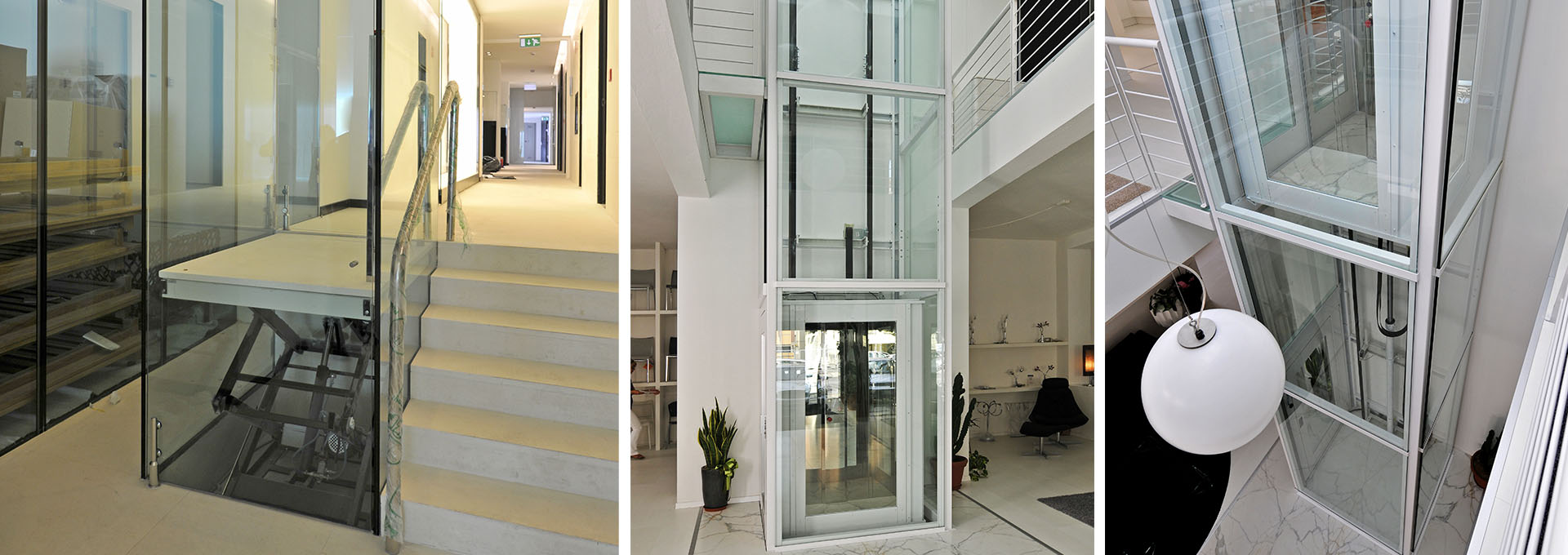
Passenger is a line of platform lifts that is ideal for private living solutions or businesses. Bertazzoni Ascensori's platform lifts can be used in absolute safety by anyone. They are the ideal means to adapt to current standards regarding the removal of architectural barriers.
The Platform integrates perfectly with any setting and is able to adapt to limited spaces, offering a great balance between style and simple use, with automatic sliding, hinged or bellows doors, with cabin doors and automatic call manoeuvre, or without cabin doors and constant pressure manoeuvre.
PLATFORM LIFT TYPES
Passenger 42
Platform lift types comply with the new machinery directive, 2006/42/EC. This new directive, in force since 30/12/2009, allows the application of cabin doors to make AUTOMATIC manoeuvres possible With this characteristic, the platform lift becomes a small life with a maximum speed of 0.15m/s.
Passenger 42 Hydro
A platform lift with a machine cabinet, which can be placed at a suitable distance and in limited spaces. The control panel uses limited amounts of power, in line with a common domestic appliance.
Passenger-42 Belt
Elettrica MRL, which features a complete lack of any machine room, has all of the equipment integrated into the shaft, and the control panel is perfectly integrated into the jamb of the landing door. Power consumption is reduced to less than 1 kWh and standby is certified in class A.
Passenger Free Sky
This features a complete lack of headroom in the shaft, where there is no upper floor. The closing surface is completely flush and equipped with presence sensors to guarantee maximum safety for the user.
Passenger LR
Platform lift for small differences in level, covering a maximum of 2 metres. The hydraulic pantograph drive can be equipped with or without cabinet for the control unit.
Passenger HC
The perfect compromise between the need for vertical mobility for people and goods. With hydraulic rationing, it can achieve a capacity of 1500 kg.
Flexstep
FlexStep Compact is the perfect line of platform lifts for installation in areas where space is a premium. Designed to overcome architectural barriers and usable by anyone in a wheelchair or by others with motor problems. This is the most space-saving solution on the market and at the same time, it offers a top-level design that can even satisfy the most demanding users.
GET INTO LINE WITH REGULATIONS WITH OUR PLATFORM LIFTS
Bertazzoni Ascensori’s platform lifts are the ideal way to get into line with current regulations on the abolition of architectural barriers. Ministerial Decree from the Ministry for Public Works no. 236 of 14 June 1989, regulates the “Technical prescriptions necessary to guarantee accessibility, adaptability and visitability of private housing and residential and public housing, concessional and subsidy, in order to overcome and eliminate the architectural barriers.”
Here, in article 8.1.13 it is said that platforms can overcome differences in height, which as a regulation do not exceed 4 m, with a speed not over 0.1 m/s need to comply, insofar as compatible, with the technical specifications for stair elevators. These platforms and their shaft, must have the relevant protections and two accesses, complete with gate. Shaft protection and the lower level gate must be sufficiently high to prevent all access to the area under the platform.
SAFETY REQUIREMENTS
Subsequently, the EN 81-40 and EN 81-41 amended the framework of regulations, defining the fundamental safety requirements for machinery. These include speed variables that are lower than or equal to 0.15 m/s, stair elevators and platform lifts. The notified body is obliged to issue an EC examination certification if the platforms have a vertical lift height above 3 metres. Article 8.1.13 is apparently less prescriptive compared to article 8.1.12 regarding lifts. In this latter, the possible installations are classified, varying the dimensions of the floor area according to the intended use of the building.
If this is a residential or non-residential building and if overcoming the architectural barriers concerns a new structure or a building during renovations. It is also necessary to consider that the accesses are located on the same side, adjacent or opposite.
USFEUL AIDS
In case of platforms, the article does not even indicate the useful floor space in the cabins, referring to the shaft generically. This apparent lack of clarity is understandable considering the fact that lift platforms are in effect considered “disability aids”.
Already in the early 1990s, the legislator wanted to use the concept of disability, implying that it was a word regarding a “sphere of activity”. The Law 104/92 “Framework law for assistance, social integration and he rights of people with disabilities”, provides an unambiguous definition of the concept of disability, as “every limit or loss in the capacity to carry out an activity in the manner or to the extent considered normal for a person”. The various disabilities include motor problems. Elderly people, pregnant women, and children are considered people with reduced mobility.